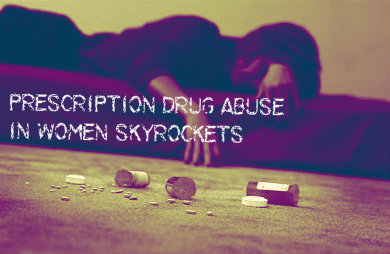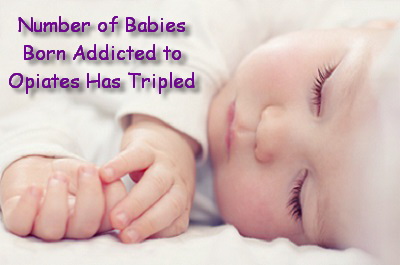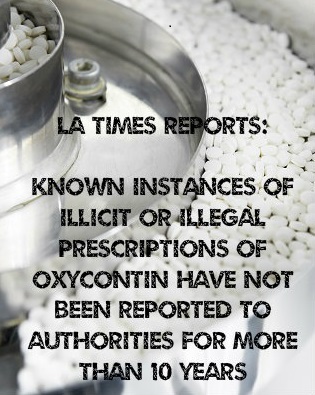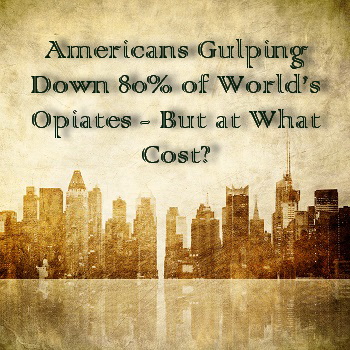18 Sep 2013
Prescription Drug Abuse In Women Skyrockets
Deaths among women from prescription pain medications are on a steep incline, according to a recent study by the Centers for Disease Control and Prevention (CDC). The study reported that deaths among women due to prescription painkiller abuse grew five-fold from 1999 to 2000. During the same time period, deaths from prescription painkiller overdoses among men grew by 3 ½ times its previous rate. This report highlights the longstanding problem of widespread abuse of prescription pain drugs among women—a problem that has often been overlooked or minimized.
Drug abuse in general, including abuse of prescription painkillers, is often viewed as a bigger problem for men than for women. While it is true that men do make up a larger percentage of all drug abusers, prescription painkiller abuse has affected women in larger numbers for more than a century. And while there are still more yearly deaths among men from prescription drugs—including prescription painkillers—the rapid spike in deaths among women in recent years means that the gender gap is quickly closing.
Painkiller Abuse In The 19th Century
 Epidemiological reports from the 19th century estimate that women made up 65 percent to 75 percent of all individuals addicted to opium. This was often the result of self-medication, the use of unregulated “patent” medicines, or irresponsible and inappropriate prescriptions on the part of qualified physicians. In this century, women were often unnecessarily medicated even by qualified professionals due to the prevailing belief of the time that women were fragile and unable to cope with physical pain or emotional distress without assistance. Women were often treated for a vague complaint known as neurasthenia—characterized primarily by fatigue, headaches and irritability—as well as other “disorders” whose existence have now been largely discredited.
Epidemiological reports from the 19th century estimate that women made up 65 percent to 75 percent of all individuals addicted to opium. This was often the result of self-medication, the use of unregulated “patent” medicines, or irresponsible and inappropriate prescriptions on the part of qualified physicians. In this century, women were often unnecessarily medicated even by qualified professionals due to the prevailing belief of the time that women were fragile and unable to cope with physical pain or emotional distress without assistance. Women were often treated for a vague complaint known as neurasthenia—characterized primarily by fatigue, headaches and irritability—as well as other “disorders” whose existence have now been largely discredited.
Modern Drug Use Among Women
As early as the 1960s, studies have shown that women make up the majority of prescription drug users in the United States. This includes painkillers, psychoactive medications and antidepressants.
There are a variety of possible reasons for this gender imbalance. For example, modern studies have provided evidence that women experience more chronic pain than men do, or at least seek treatment for chronic pain more frequently. Women who use prescription medications report many other factors that contributed to their decision to seek treatment for physical or mental distress. These factors often include gender discrimination in work or social settings, the economic and emotional challenges of being the primary caregiver or a single parent, and societal expectations.
Studies have show that when women are prescribed pain medication, they are more likely to be given higher doses and medicated for a longer period of time than their male counterparts. One possible explanation for this phenomenon is that men remain more likely to have jobs involving manual labor with high risk of short-term injuries. In contrast, women are more likely to experience chronic pain when reaching middle age and seek treatment over a long period of time.
With a large and rapidly growing number of women taking prescription painkillers, the odds increase that a certain number of these women will develop physical dependencies. Many prescription pain medications, including Vicodin and morphine, are opioid drugs that are highly addictive.
Equal Opportunity Drug Abuse
Since as early as the 1920s, the overwhelming majority of drug users among men have been from minority populations and economically disadvantaged backgrounds. In contrast, prescription drug abuse among women has always affected a much more varied population, from the wealthy to the working classes. Although white and Native American populations have the highest numbers of deaths from prescription painkillers, the problem is by no means unique to those demographic groups.
While women who abuse prescription painkillers do not come from one predominant economic situation or ethnicity, there is a strong trend apparent when it comes to age. The rate of deaths from prescription painkillers more than tripled among women ages 45 through 54, and also tripled for women ages 55 through 64. In the year 2010, middle-aged women in these age groups made up almost half of the overall deaths among women from drug overdoses.
OxyContin is the brand name for a specific form of oxycodone, an opioid narcotic medication known for its potential to trigger problems with drug abuse or drug addiction. Because of the medication’s association with increased abuse and addiction risks, sale of all forms of oxycodone are strictly controlled under federal guidelines. However, according to a new investigative report by the Los Angeles Times, the manufacturer of OxyContin—a company called Purdue Pharma—has failed to report known instances of illicit or illegal prescriptions of the medication to authorities for more than 10 years.
After the report in The Times, two state senators in California have called on the maker of OxyContin to turn over the names of California physicians it suspects recklessly prescribed its pills to drug dealers and addicts.
Oxycodone Basics
Oxycodone is a synthetic substance made in pharmaceutical laboratories from a specific chemical found naturally in a plant called the opium poppy. When it interacts with nerve cells in the body’s central nervous system (brain and spinal cord), it reduces the body’s ability to feel pain. The U.S. National Library of Medicine lists available forms of oxycodone that include liquids, concentrates, capsules and tablets. While some oxycodone-containing products are sold without additional active ingredients, other products also contain acetaminophen, aspirin or ibuprofen. In addition to OxyContin, oxycodone-based medications include Percocet, Percodan and Endocet.
The same mechanisms that give oxycodone the ability to ease pain also give it the ability to alter normal function in the part of the brain that regulates pleasurable sensations. It is the intensity of the drug’s effects on the brain’s pleasure centers that accounts for its association with profound risks for abuse and addiction. Because of the potential for misuse of oxycodone, federal regulators have placed it on a list of officially controlled substances called Schedule II drugs. All substances on this list have clear usefulness as therapeutic medications, but also present enough risks to warrant strong restrictions on their use.
OxyContin Basics
OxyContin comes in tablet form and was originally marketed as a safer, long-acting alternative to morphine, another opioid narcotic capable of reducing moderate or severe forms of pain. When the medication hit the market, its safe use was significantly undermined by its easy crushability. This crushability encouraged abusers to rapidly introduce OxyContin into their bloodstreams through IV injection or inhalation. In an effort to correct a widespread pattern of misuse, Purdue Pharma introduced a non-crushable form of the medication in 2009. Following the release of this new product, misuse of OxyContin dropped by almost 200 percent. However, significant numbers of people across the U.S. still use the medication illicitly or illegally.
New Findings
In 2002, Purdue Pharma started tracking doctors across the U.S. suspected of knowingly prescribing OxyContin to people addicted to oxycodone or other narcotic or non-narcotic medications, as well as doctors suspected of selling their OxyContin supplies to drug dealers. As of 2013, the company had identified more than 1,800 physicians believed to be participating in these activities. However, Purdue Pharma has never made a concerted effort to release their list of suspects to any federal, state or local law enforcement agency, or to a medical body responsible for disciplining doctor misconduct. In fact, the company has sometimes made efforts to deflect attention away from purposeful, improper OxyContin prescribing by publicly linking the illegal availability of the medication to such things as robberies, theft of OxyContin by family members of legitimate users, and patients’ efforts to obtain the medication from multiple doctors.
Purdue Pharma only openly revealed the existence of its internal list of misprescribing physicians in June 2013. Because of the immense profitability of OxyContin, some investigators and public health officials have openly questioned the company’s motivations for not revealing its knowledge on the issue at any point in the last 10 years. Spokesmen for Purdue Pharma counter these criticisms by asserting that, while they have never released the names of all suspected doctors, they have separately given medical groups and law enforcement officials the names of 154 of the 1,800 physicians in their database. However, since no one outside the company has seen the full list of suspected misprescribers, there is no way to independently gauge the accuracy of these statements.
Considerations
Some of the doctors under investigation for illegally prescribing or selling OxyContin have been involved in widespread distribution efforts that meet federal and state standards for drug dealing. For instance, one California physician was recently convicted of illegally selling over 1 million doses of the medication. Another doctor prescribed millions of dollars worth of OxyContin and other opioid narcotics to people known to have problems with drug addiction. Officials from Purdue Pharma state that they have no legal obligation to assist law enforcement or medical regulators in their efforts to control OxyContin’s availability.
You would be forgiven for thinking that the prescription drug epidemic affects only the users themselves. Abusing medicines such as Vicodin and OxyContin—opiate drugs with chemical similarities to heroin—puts the users at significant risk, killing more Americans than heroin and cocaine combined in 2008; but using when you’re pregnant presents a whole new class of risks. Babies of opiate-using mothers can be born in withdrawal, their systems shocked by the abrupt withdrawal of substances, and research has revealed that this is happening more and more frequently in the United States. In fact, three times as many babies were born with neonatal abstinence syndrome (NAS) in 2009 than in 2000, reflecting the rapid rise in the prescription drug problem.
The Study
Lead researcher Dr. Stephen Patrick had noticed an increase in the number of babies with NAS at CS Mott Children’s Hospital at the University of Michigan, and set out to determine whether the numbers were also increasing across the country. The researchers looked at discharge records from 2000, 2003, 2006 and 2009 from a database of patients that covers 44 states and over 4,100 hospitals. When the researchers determined which of the births were associated with opiate use, they revealed some shocking statistics about the extent of the problem.

They found that the number of pregnant women abusing opiate medicines when the baby was being delivered was five times higher in 2009 than in 2000. In addition, the researchers found that the rates of illicit drug use during pregnancy were 16.2 percent of teens and 7.4 percent of adults. Generally speaking—and somewhat obviously—any drug use during pregnancy poses some risk to the infant since they’re getting small doses of anything the mother takes.
As you might expect with the increase in numbers of opiate-using mothers, the number of babies born with NAS has also increased significantly. The rate almost tripled over the experimental period, from 1.20 per 1,000 births up to 3.39 in 2009. This has a disturbing parallel with the numbers of overdose deaths from prescription painkillers since the 1990s, which has also increased three-fold. The problem can’t exist in a vacuum—related issues, like babies born with NAS, are bound to increase as well.
What Is NAS?
NAS is a condition that occurs when the baby becomes addicted to drugs along with the mother when it’s in the womb. It isn’t just opiate drugs that can lead to it: marijuana, benzodiazepines, cocaine, amphetamines and the use other substances can also result in NAS. The symptoms include excessive or high-pitched crying, fever, irritability, tremors, sweating, sleep problems and sneezing or a stuffy nose.
The researchers also found that the babies born with NAS were over three times more likely to have respiratory problems and over twice as likely to have a low birth weight. Interestingly, they were also notably more likely to be covered by Medicaid, meaning that the issues were more common in low-income families.
Better Treatment or Prevention?
The researchers also looked at the average length of stay for the newborns with NAS, which they noted hasn’t decreased over the last decade. From their perspective, this represents an area in need of improvement for physicians. Since state Medicaid programs bear much of the brunt of the problem, there is a lot of motivation to improve care for opiate-addicted pregnant women. The researchers argue that since there are no standardized clinical guidelines for treatment of NAS, it is possible to improve care for the babies themselves, possibly using a combination of an opiate and another medicine such as clonidine, but breastfeeding can also help.
The other suggestion is to enroll opiate-addicted mothers in methadone programs or provide them with drugs such as buprenorphine, which is often used in cases of opiate addiction. If these interventions were successful, the numbers of babies born with NAS would decrease, rather than just the amount of time they have to spend in treatment as a result of it.
Clearly, prevention of NAS is a considerably better solution than merely determining a better way to treat babies suffering from it, but the problem impacts much more than pregnant women. The rates of prescription painkiller abuse across the U.S. are on the rise, so this research serves as yet another reason to address that problem.
Amelia liked to think of herself as a survivor—soft but strong, able to persevere. Raised by a mother with mental illness, she knew a lot about how to handle difficult people and delicate events; it seemed she’d been walking on eggshells for as long as she could remember. Her father had left when she was 12 and the care and keeping of her mother, who only grew more unstable as a result, had fallen exclusively to Amelia. By the time she was 17, she was an expert on her mother’s medical records, how and when she needed to take her medication, and was working to support the two of them. She never made it to college. Maintaining a full-time job and the constant attention required in the care of her mother didn’t leave time for school.
As anxiety settled in throughout her 20’s and with the occasional “dark moods” that lasted months sometimes, Amelia found herself less and less capable of enduring not the physical hardship, but the psychological. Still, she wanted nothing to do with therapy; why should she spend upward of $100 an hour talking about herself? Life was just the way it was. When headaches started to overtake her, she finally saw a doctor.
Offering her full history to the small town general practitioner, Amelia was persuaded to provide a background. She discussed not only her unrelenting headaches but also the steady sense that things simply weren’t right—how she shook nervously and sweated. Her GP prescribed benzodiazepines to be used for acute episodes of anxiety and opiates for what he determined were migraines.
For a while, Amelia found comfort in the hypnotic quality of the drugs. It was as if she were floating somewhere just outside herself and nothing could harm her there. As weeks and months wore on, however, Amelia discovered that the recommended dosage no longer treated her anxiety or her pain. She began to increase her dosage. When she was threatened with eviction after one of her mother’s “incidents”—she’d taken after the neighbor with a garden hoe—it all became too much. Amelia made it through the experience relatively unscathed, but she’d discovered something useful to her: her medications were more powerful when combined with wine.
It wasn’t until a friend noticed how much Amelia was taking that she questioned it herself. She realized she’d been relying exclusively on the medication and the sense of escape it gave her, taking it every four hours whether she needed to or not. But when she tried to quit she discovered something even more alarming—she couldn’t.
Gendered Differences in Addiction
The CDC reports that between 1999 and 2010, opioid overdose deaths among women increased fivefold, while the numbers for men increased three times. Since 2007, more women have died from prescription overdose than in car accident related injuries, cervical cancer or homicides. Further studies reveal that while women tend to become addicted later than men, they do so more quickly. Once addicted, women are more vulnerable to relapse, and are less likely to seek treatment than men. According to Constance Scharff, Ph.D., “Women most often use drugs to deal with stress and regulate moods.” Women are prescribed potentially addictive medications more often than men, and for longer periods. This may be because women are speaking more openly with their doctors about both physical and psychological complaints, but the reasons are not entirely understood.
Prescription drug dependence may go unnoticed even to the user—many believe that because the medications are prescribed, they are safe. When more than the recommended dosage is being used and for longer than is required and when symptoms of withdrawal (such as nausea, agitation and sleep disturbance) occur at the cessation of the medication, addiction should be considered.
High-Risk Group
Recovery from prescription drug dependence is as important as any other addictive substance or process. The White House considers women to be among the top three high-risk groups for addiction, and looking at the numbers for accidental overdose deaths, it is no wonder. Long term abuse of certain addictive prescription medications, such as the benzodiazepines, carry potential consequences: “over sedation, impairment of memory, balance and learning, depression and emotional blunting.”
Treatment for Prescription Drug Addiction
Treatment for prescription drug addiction is similar to other treatments for addiction; it consists of a behavioral component wherein addicts learn to cope with life stress or physical pain without the use of medications, and where previous users are taught to become self-observant and proactive when cravings arise. There is evidence that psychotherapy in combination with NA group attendance, or another form of collective substance abuse support, can be effective in helping women recover. Given the high pressure lives that so many modern women contend with—where work outside the home is a foregone conclusion even while work inside the home does not diminish—the stress and pain that lead many down the slippery slope of secret addiction is unsurprising. What is most important is that women like Amelia find the help they need to recover—including doctors who better understand the risks of prescribing medications known to create dependence.
Across the U.S., public school health classes and counselors continue to teach about the dangers of drugs like alcohol and cocaine. In the last few years, however, students have begun to learn about what public health officials are identifying as a much larger problem: prescription drugs.
Last year, the pharmaceutical industry released a statement saying that 4.02 billion prescriptions were written in the U.S. in 2011. This comes out to about 13 prescriptions for every American, an all-time record in the U.S. But are all these prescriptions fueling the current prescription drug addiction and overdose rates?
The Statistics
- U.S. doctors wrote 4.02 billion drug prescriptions in 2011.
- According to the CDC, nearly half of the U.S. population has taken at least one prescribed drug during the last month, and more than 20 percent of the U.S. population has taken three or more.
- More than 75 percent of doctor office visits involve prescription drugs.
- More Americans die from prescription overdose than from cocaine and heroin combined.
- Since 2008, more Americans die from prescription overdoses than from car accidents every year.
- In 2011, 16,500 Americans died from prescription painkillers alone.
- Since 2000, the number of prescription overdoses has more than doubled among men, and more than quadrupled among women.
- Americans consume 80 percent of opiate painkillers produced worldwide.
- An estimated 36 million “serious adverse reactions” to prescribed medications in the U.S. every year.
A Growing Epidemic
The dramatic rise of drug prescriptions written every year in the U.S. seems to mirror the alarming rise of prescription drug overdoses, and many experts, including doctors and public health officials, are looking at the issue more seriously. These drugs are very beneficial, but at what cost? Some of the more popular prescribed drugs happen to be some of the most familiar, appearing in magazine, radio and television ads across the country. A recent report released by a London medical journal states that for every $1 spent on researching a particular drug, an additional $19 is spent on promotion and marketing.
The Country’s Most Popular Prescribed Drugs
The numbers of prescriptions written have risen for many drugs across the board in the last decade, and certainly in the last several years. Note that many of the county’s best sellers are not often involved in many overdose deaths (with the exception of hydrocodone). As of 2010, the most popular prescribed medications include:
- Hydrocodone (opiate combined with acetaminophen/Tylenol): pain reliever
- Zocor: drug treating high cholesterol
- Lisinopril: drug treating blood-pressure
- Synthroid: synthetic thyroid hormone
- Norvasc: drug treating blood-pressure
In 2011, the figures changed somewhat, with the anti-depressant Zoloft taking the top slot, followed by the cholesterol medication Lipitor. Sales of drugs treating attention-deficit hyperactivity disorder also jumped, rising 17 percent from 2010.
Most Dangerous Prescribed Drugs
As fatal prescription drug overdoses continue to climb, scientists have been focusing their research on the main drivers behind the epidemic, trying to find which drugs are most likely to cause harm. Opiate painkillers, with their powerful addictive and sedative properties, continue to top the charts and include popular painkillers like OxyContin, Hydrocodone and Vicodin. However, doctors have been aware for some time that taking multiple prescription medications heightens the risk of an overdose.
Medical News Today, for example, reports that many reported fatal overdoses have involved multiple prescription drugs or alcohol. A group of anti-depressants known as benzodiazepines (which includes brand names such as Xanax, Valium and Ativan) seem to be a major contributor, and are involved in about 30 percent of opiate painkiller deaths. This is the first study to point toward a particular group of medications as a dangerous combination with opiates. The danger of alcohol in conjunction with opiates, however, is very well documented.
Of all prescription overdose deaths in the U.S., the ones most commonly involved, alone or in combination with others, are listed below:
- Opioid painkillers: found in about 75 percent of overdoses
- Benzodiazepines: found in about 30 percent of overdoses
- Anti-depressants: found in about 17 percent of overdoses
- Drugs for epilepsy and Parkinson’s: found in about 8 percent of overdoses
The Industry’s Response
The pharmaceutical industry greeted the latest numbers on written prescriptions with enthusiasm. After all, it’s a sign that the industry is growing. When confronted about the alarming rise in prescription drug deaths, manufacturers like Purdue have so far responded with statements about their labeling practices and commitment to working with government officials.
Medical News Today has pointed to unethical online pharmacies as part of the problem. It’s true that recent studies show a link between Internet access and an increase in prescription drug abuse, but doctors are still wary, stating that more studies need to be done. Most likely, online pharmacies (like some corrupt pharmacies elsewhere) comprise just one of many venues that addicts use to get their drug of choice.
Perhaps simply stating that patients and doctors need better communication, or that patients need to read labels more carefully, isn’t enough to combat the problem. After all, Americans consume 80 percent of the world’s supply of opiate medication every year—does this really mean Americans are in more pain than everyone else, or is this a reflection of a broader problem? Whether or not the pharmaceutical industry has any responsibility in the rise of overdose deaths, the problem remains and affects everyone, from preteens to the elderly. Unlike the scary drugs we all learned about in school, these drugs are used and abused by almost every demographic. Complicating the issue even further, these same drugs also help save and improve lives. The question now should be: how do we lower abuse and fatality rates of prescription drugs without restricting access to the patients who really need them? It really is a tough question to answer.
Daphne sat across the table from her husband and mouthed the words, “I hate you.” Then she painted a charming smile on her face and ordered a salad. She and Sam were out to dinner with his family, something they did only rarely because of what Sam’s mother referred to as “Daphne’s drinking problem.” What no one at the table knew was that Daphne had a gram of cocaine in her clutch and no plans to drink more than one cocktail. To everyone’s surprise, a single margarita is all she had that night.
For the next four weeks, Daphne’s behavior was erratic. She didn’t find herself sneaking bottles of wine or vodka, passed out on the sofa in front of the television or lying in the floor of their shared walk-in closet, crying her eyes out over every conceivable wrong done to her in the past. Instead, she was scarce, hardly ever at home. When he did see her, she was wild with energy and ideas, frenetic to dress and shower and be off again. Her already thin frame appeared unusually slight. It didn’t look as though Daphne had been eating, or really doing anything but moving, fast.
Then on a Sunday afternoon, just like it had started, Daphne was suddenly home again—collapsed on the lawn, so drunk Sam could nearly smell the alcohol from the front door. Ever the co-dependent faithful partner, he walked to his wife and bent to scoop her into his arms. And just like clockwork, Daphne began to slur a litany of praise for her husband, how she could not live without him, how he was perfect in every way.
Days into Daphne’s return, however, she was threatening to stab herself with a kitchen knife if Sam didn’t give her access to all of her pain medication. Daphne received prescription opiates for a cracked cervical vertebra, and Sam sometimes hid them when Daphne’s drinking binges got especially bad. When she took the knife and started carving shallow cuts into the inside of her arm—something Daphne had done many times before, but always in private—Sam knew it was time to do what he had not yet done. He had his wife involuntarily hospitalized. An emergency hospital stay turned into a longer, voluntary in-patient psychiatric stay, and it was there that Daphne was formally diagnosed.
She was an alcoholic. She was a drug addict. She had anorexia. She had bipolar disorder. And she had borderline personality disorder. No one had expected this outcome, least of all Daphne.
Mental Disorders and Addiction
When a person has both a problem with addiction and a mental disorder, he or she is said to have a dual diagnosis (or comorbidity). Many times, substance abuse can mask the signs of mental illness. Traits or characteristics of mental illness, which may otherwise be quite noticeable to close family members and loved ones, cloak themselves in the depressed behavior brought on by excessive alcohol use (alcohol is itself a depressant), or the erratic behavior others exhibit whether using alcohol excessively or when high or seeking drugs.
People with certain mental disorders may seek to “self-medicate” the anxiety or depression that arises as a result of the disorder by consuming alcohol or using drugs, or a combination. One such disorder is bipolar disorder. About 56 percent of people with bipolar have experienced drug or alcohol addiction. The personality disorders, such as borderline personality disorder (BPD), also share a high rate of dual diagnosis. According to the Center for Drug and Alcohol Programs at the Medical University of South Carolina, “Over 50 percent of drug abusers and almost 40 percent of alcoholics have at least one serious mental illness.”
Besides bipolar and BPD, depression, anxiety disorders, schizophrenia and other personality disorders frequently co-occur with substance abuse. Psychiatric issues can begin before or after the onset of substance abuse.
Treatment for the Dual Diagnosed
There is no question that adding disorders and substance issues to the mix significantly compounds an individual’s stress and further complicates treatment options. Those who have co-occurring mental disorders have a higher rate of relapse when it comes to getting sober. But even people with mental disorders and co-occurring substance abuse issues can begin to heal. What helps is an integrated therapeutic approach—where mental health treatment and addiction recovery are not thought of as separate, but fused into an integrated whole. Compartmentalizing too many areas of her life is often how an addict with mental health issues gets to the place in which she desperately needs recovery, so seeing her life as a working whole is important.
Thinking, “I cannot attend to my sobriety if I do not attend to my bipolar disorder” and vice versa is a good way to think about it. It’s quite true, in fact—not simply a bromide offered by practiced faces in the business of therapy.
While Daphne’s situation may seem extreme, it is likely that the deeper part of her issues are connected. When she begins to do the work to unravel what the deeply held beliefs and long-held stories that most affect her mental state are, she may begin to find herself experiencing better balance—and an ability to deal with the boat-rocking experience of finding herself with a half-dozen labels, all too frightening to think about in the beginning.
Becoming educated about the nature of addiction and the reality of mental illness is a good place to start. Choosing to look at one’s life carefully is the opposite of what addiction means. When you wrestle the hydra of addiction and mental illness, you know you’re only going to get more of the same. Better not to go in swinging but with clarity, a willingness to learn and possibly, maybe, a little bit of room for something like hope.
Prescription drug addiction—especially to opiate painkiller medicines like fentanyl—is killing Americans in alarming numbers. In 2010, more than 12 million Americans reported using a prescription painkiller non-medically, and the rates of overdose deaths have more than tripled since 1990. Painkillers are responsible for more deaths than heroin and cocaine combined—so the legitimately prescribed medicines sitting in your cabinet currently pose a bigger public health risk than the illicit narcotics found on street corners.
Since drug addiction is a disease that does significant damage to the health and lives of those affected, many people would like to believe that their insurance provider will look out for them if they spiral into self-destruction. A new report reveals, however, that this is far from the truth. In reality, insurers place numerous restrictions on those seeking medicines that have been shown to help people struggling with opiate addiction.
The Epidemic of Prescription Painkiller Abuse
More and more people are becoming aware of the risks of prescription painkiller abuse, but the death rates still paint a shocking picture of the state of pain management in the U.S. The main issue is that we’re still dependent on opiate medicines (which bear close chemical similarities to illicit drugs such as heroin) and these have a significant risk of addiction and also a notable potential for overdose. Taking too much of a prescription painkiller can produce euphoria. As a result, many people who are prescribed these medication s find themselves regularly exceeding the recommended dosage from their doctor. According to the CDC, sales of prescription painkillers like Vicodin, OxyContin, Percocet and Duragesic have increased by 300 percent since 1999, providing a startling parallel to the rates of overdose death.
s find themselves regularly exceeding the recommended dosage from their doctor. According to the CDC, sales of prescription painkillers like Vicodin, OxyContin, Percocet and Duragesic have increased by 300 percent since 1999, providing a startling parallel to the rates of overdose death.
The key point is that drug addiction is a chronic, relapsing disease just like asthma and diabetes, and users (while they may have chosen to take the substance initially) quickly lose control over their behavior and are unable to stop taking the drugs. Their brains have adjusted to the continuous supply of opiates, so that without them they’re left unbalanced and can experience unpleasant withdrawal symptoms. This means that patients experiencing chronic pain are given medicines that can easily lead them into addiction—even if they have a legitimate reason for taking large doses of the medicine. Just like asthmatics can’t choose to re-open their airways and diabetics can’t increase their insulin levels through sheer willpower, those struggling with addiction can’t just stop craving drugs.
Treatment Is Available
This is why, alongside psychological interventions, drugs such as methadone, buprenorphine and naloxone have been developed to help people struggling with opiate addictions. While methadone and buprenorphine are used to help users gradually decrease their opiate consumption, naloxone is used specifically to counter the effects of an overdose. The key point here is that medicine that could help with the epidemic is available; it isn’t that the medicine doesn’t work or hasn’t been invented.
Insurer Restrictions
It is clear that while opiate painkiller abuse is one of the most significant causes of death in the U.S. today, a mixture of psychological and pharmacological interventions can be used to treat anybody affected. The only problem is that they often aren’t being used and the paper from the Avisa Group—which was commissioned by the American Society of Addiction Medicine—reveals the reasons in undeniable detail.
Firstly, it shows that rural or especially poor areas have higher rates of overdose from prescription medicines, and that Medicaid users are also at an increased risk. The Affordable Care Act, due to come into effect in January, will dramatically increase the numbers of drug-addicted Americans enrolled with Medicaid and other health insurance plans. This sounds like a good thing, but the benefits are limited when you consider the wide range of restrictions placed by providers on the users of medicines like methadone, buprenorphine and naloxone.
The list of restrictions is unfortunately long and inevitably causes a great deal of harm by making it harder to access potentially life-saving medicines. Some medicines aren’t covered by specific insurers or state Medicaid programs, there are limits on the dosages allowed (which don’t always allow for the recommended dosage of the medicine), unrealistic limits on refills and limits on the amount of medicines such as buprenorphine and methadone that you can be prescribed over the course of your lifetime (which are unheard of for other medicines).
Perhaps most shockingly, the insurance companies require authorization and re-authorization processes to be completed, which become more complex the more times a patient has to complete them. These include things like the requirement of counseling before authorization is granted, and this often also involves the insurance companies demanding the counselor’s treatment notes and the patient’s attendance records before making a decision. In many cases, cheaper treatments (which are considerably less likely to be effective) must be tried before authorization is granted, and the entire process can take several days or even weeks. During this time, it’s inevitable that some drug abusers relapse, overdose and die as a result.
Still Fighting Stigma?
The fact that such restrictions don’t exist for other medicines is the worst point revealed by this report, because it essentially shows that addiction is still being stigmatized. How you can morally justify imposing a lifetime restriction on treatment for somebody suffering from a chronic condition is completely beyond comprehension. Nobody would tell a diabetic that they’ve used up their lifetime supply of insulin, yet it’s commonplace for drug users to be told the equivalent. It reflects a deep-seated assumption that drug addiction is somehow a “choice,” and this assumption must be shattered if we’re ever to reduce the public health impact of prescription painkiller addiction.
Pain medications are often prescribed for chronic pain related to other medical conditions, such as cancer or an injury that results in ongoing pain. In all cases, the prescription of a pain medication to relieve pain must be weighed against the potential negative consequences of using such a medication, including not only side effects but also the risk of addiction.
In addition, the pain is best managed when there are follow-ups to the prescription that include assessments of pain levels and examination of co morbid conditions. In a recent study, researchers led by Leslie R.M. Hausmann, PhD of the Veterans Affairs Pittsburgh Healthcare System and Assistant Professor of Medicine at the University of Pittsburgh discovered that there are significant disparities between races in how pain management is executed.
The researchers found that the differences are present in the monitoring of opiods and in the follow-up routines. The recommended guidelines include assessing patients for the effectiveness of the medication, as well as screening them for evidence of drug abuse. The study’s findings appear in a recent issue of the journal PAIN.
The study’s focus included several measurements of pain management defectiveness, including the physicians’ implementation of an opioid agreement, measurement of pain levels at follow-up exams, inclusion of urine screenings for drugs and referrals for pain clinics and substance abuse treatment.
The retrospective design incorporated health records representing 1,646 white patients and 253 black patients. The data was taken from electronic health records that met certain criteria. The patients were all prescribed opioids for pain not related to cancer at the Veterans Affairs Pittsburgh Healthcare System pharmacy and used the medication for at least 90 days. The records were all from October 2007 to September 2009.
The researchers also assessed data about prescription painkiller follow-up and monitoring practices for the 12 months following the prescription period, to form a complete profile of the pain treatment.
The patients were 94 percent male and 22 percent were over the age of 65. Forty-five percent were married or living with a partner, and were most commonly treated for joint or back pain. Approximately one half of the patients had a co morbid mental or physical health condition, and one-third of the patients had a past of substance abuse.
 When comparing the patients, the black patients were younger, less liable to have pain in their back, and had more physical co morbidity and higher pain levels recorded. The black and white patients were similar in history of drug abuse.
When comparing the patients, the black patients were younger, less liable to have pain in their back, and had more physical co morbidity and higher pain levels recorded. The black and white patients were similar in history of drug abuse.
However, major racial differences were discovered as pertained to monitoring of pain prescription use and the effectiveness of the medication. Black patients seemed less likely to be monitored for pain levels during medical exams and among those patients given a urinalysis, black patients were tested more often, and particularly if they were prescribed a higher dose of medication.
Black patients also were less liable to receive a referral to a specialist for pain treatment and were more likely referred to a substance abuse treatment facility after taking prescription opioids.
The findings indicate that when black patients are prescribed opioid medications for pain treatment, they may not be receiving similar follow-up and monitoring practices that may maximize the benefit of their pain management treatment.
Read more about Dispelling Racial and Socioeconomic Myths About Drug Users





